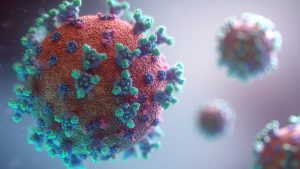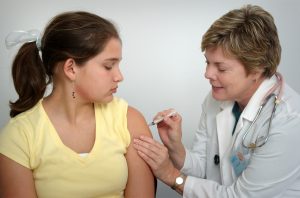The Immune System: Viruses and Vaccines
Learning Objectives
Know how the body responds to infection.
Know what a virus is and how it attacks the body.
Understand how vaccines can prevent infection.
As humans, our immune system is responsible for many things; however, the main purpose of the human immune system is to limit and fight infection to maintain a healthy body. Some people are more prone to infection than others so they get sick more often, but how does the body respond to sickness?
There are many responses that happen once an infection occurs. Once an intruder is inside the body, the body recognizes that it has an infection and begins to fight it off.
The first step in fighting it off is an innate response which results in inflammation and other minor symptoms like a cough and fever. This helps to begin fighting off an infection while the big guns are being prepared to come in and restore the body’s health. The adaptive response is what helps to build immunity using T and B cells.
T cells and B cells are the big guns because they help to fight infection and create immunity. Once T and B cells fight off the infection, T cells send out B cells to create antibodies while also killing infected target cells. To prevent the same infection again, B cells create antibodies so in some cases you are immune to that sickness.
Viruses are very tricky to fight off because there are less medications that help. So, what is a virus and why is it harder to treat?

Viruses (Figure 1 )are pathogenic antigens that are microscopic. What is unique about viruses, is that they have either DNA or RNA in their genetic makeup just like humans. A virus takes over a living cell and causes it to produce more copies of itself, which is why it spreads so fast and is harder for the body to fight.
Although in some cases it is difficult to treat, there is a way to prevent these viral infections.

A vaccine is one way to prevent viral infections. Vaccines are essentially a dead or weakened strain of a virus that is put into the human body (Figure 2).
This may seem like a very bad idea, but as mentioned earlier, once you develop antibodies for a disease you could get immunity from it. This is why we get flu shots each year, to develop antibodies of the flu so our body can be immune from it. As the dead or weakened strain of a virus is acknowledged by the body, T cells instruct B cells to make antibodies for the virus, building immunity against it.
Inflammation is a rapid increase in blood flow and heat conduction in an area of the body. Often it is accompanied by pain, ichyness, redness and swelling.
Immunity is when something can no longer make you sick. If you can no longer get sick from it, you have an "immunity" to that sickness.
Antibodies are proteins in the body that label intruding bacteria
infectious agents; they are what cause human sickness and disease.
Deoxyribonucleic Acid (DNA) is the genetic instructions that cells follow to do their work.
Ribonucleic Acid (RNA) is half of a Full DNA fragment.

